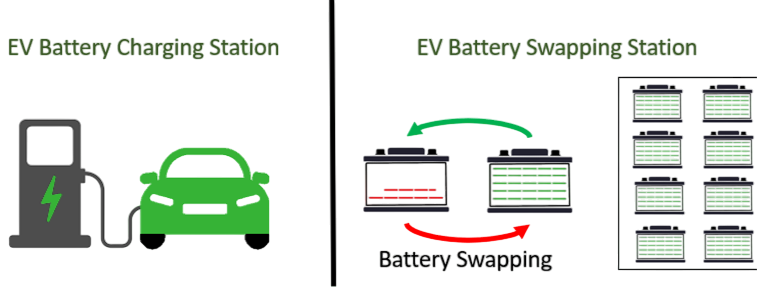
- Battery Swapping Electric Vehicles
- What is Battery Swapping?
- Technology Behind It
- Infrastructure Requirements
- Need for Battery Swapping
- Battery Standards
- Benefits Over Plug-in Charging
- Challenges in Adoption
- Global Examples
- Conclusion
Battery Swapping Electric Vehicles
Battery swapping is emerging as a revolutionary concept in the electric vehicle (EV) industry, aiming to address the limitations of conventional plug-in charging methods. With the global shift towards clean energy and sustainable mobility, innovative solutions are being developed to overcome the infrastructure and time constraints that hinder EV adoption. To understand how intelligent systems accelerate these innovations through predictive analytics, smart grid management, and real-time optimization, explore Artificial Intelligence Training a hands-on course that covers machine learning, embedded AI, and sustainable technology applications for the future of mobility. Battery swapping, where a depleted battery is exchanged for a fully charged one at a swapping station, is gaining popularity as a faster and more efficient alternative. This essay explores the need, technology, infrastructure, standards, advantages, and challenges associated with battery swapping, with a focus on global practices and the Indian context.
What is Battery Swapping?
Battery swapping is a method of charging electric vehicles where instead of plugging the vehicle into a power source, the vehicle’s depleted battery is replaced with a fully charged one. This process requires precise monitoring of battery health, charge cycles, and compatibility to ensure safety and efficiency. To understand how these critical checks are performed and managed, explore Battery Management System a comprehensive guide that explains battery monitoring, thermal management, charge balancing, and the role of BMS in enabling advanced solutions like battery swapping.

The process is facilitated at specialized stations that store and charge multiple batteries simultaneously. This system is particularly useful for commercial EVs such as two-wheelers, three-wheelers, and public transport vehicles that require quick turnaround times. The process involves automated or semi-automated systems to ensure that the battery is exchanged in minutes, eliminating the waiting period associated with plug-in charging. The concept of battery-as-a-service (BaaS) also complements this system, wherein users do not own the battery but subscribe to a battery plan and only pay for the energy consumed.
Ready to Get Certified in Artificial Intelligence ? Explore the Program Now Artificial Intelligence Online Training Offered By ACTE Right Now!
Infrastructure Requirements
Setting up a battery swapping infrastructure requires significant planning and investment. The major requirements include standardized battery designs, robust safety protocols, efficient logistics, and widespread accessibility to ensure seamless adoption. To understand how these elements connect with India’s growing charging ecosystem, explore EV Charging Stations a comprehensive guide that explains charging hubs, station networks, government initiatives, and the role of infrastructure in supporting both battery swapping and conventional charging models.
- Swapping Stations: Strategically located at high-traffic areas, logistics hubs, and fuel stations.
- Battery Charging Facilities: On-site or centralized charging stations to recharge returned batteries.
- Battery Inventory Management: To ensure the availability of fully charged batteries.
- Power Supply and Backup Systems: Reliable electricity supply with backup to avoid downtime.
- Digital Infrastructure: Mobile apps and payment gateways for user interaction and billing.
Integration with smart grids and renewable energy sources is also being explored to improve sustainability and reduce dependency on conventional power sources.
To Explore Artificial Intelligence in Depth, Check Out Our Comprehensive Artificial Intelligence Online Training To Gain Insights From Our Experts!
Technology Behind It
The technology enabling battery swapping is multi-faceted and involves the integration of mechanical systems, software platforms, and energy management systems. Key technological components include battery monitoring units, thermal management systems, charge balancing circuits, and intelligent controllers that ensure safety and efficiency. To explore how these innovations shape the future of energy storage and mobility, explore EV Battery Technology a comprehensive guide that explains battery chemistry, performance optimization, lifecycle management, and the breakthroughs driving next-generation electric vehicles.
- Swapping Stations: Equipped with robotic arms or guided systems to remove and install batteries swiftly.
- Battery Management Systems (BMS): Monitor the health, charge status, and temperature of batteries.
- IoT and Cloud Connectivity: Allow real-time tracking, billing, and inventory management.
- Vehicle Design Compatibility: Vehicles must be designed with removable battery packs and standardized connectors.
Automation and AI further enhance the operational efficiency of swapping stations, reducing human intervention and error. The development of lightweight, modular batteries also contributes to the feasibility of the swapping model.
Need for Battery Swapping
One of the primary bottlenecks in the mass adoption of EVs is the lengthy charging time and the inadequate number of fast-charging stations. Battery swapping addresses these challenges by offering a quicker and more convenient solution. For fleet operators, delivery services, and public transport, time is of the essence, and swapping enables vehicles to stay on the road longer. To understand how intelligent systems optimize battery swapping logistics, reduce downtime, and improve fleet efficiency, explore Artificial Intelligence Training a hands-on course that covers machine learning, predictive analytics, and real-time optimization for next-generation mobility solutions. Additionally, battery swapping helps mitigate issues related to battery degradation, standardization, and cost. By decoupling the battery ownership from the vehicle, it reduces the upfront cost of EVs, making them more accessible. Furthermore, swapping can support better battery lifecycle management and reduce e-waste by enabling centralized monitoring and recycling.
Battery Standards
Standardization is crucial for successfully implementing battery swapping technology. It helps vehicles and batteries from different manufacturers work together. This process includes several key elements, starting with uniform battery size and design. This ensures that all batteries fit into various vehicle models. Having common connectors and interfaces is also important, as they enable interoperability across different manufacturers and simplify charging infrastructure development. To explore how these standards integrate with modern innovations in mobility, explore Electric Vehicle Technology a comprehensive guide that explains EV architecture, working principles, component integration, and the technological advancements driving the global shift toward electrification. It provides standardized electrical and mechanical connections that make the swapping process easier. Another important factor is setting up communication protocols. These enable effective interactions between the battery management system (BMS) and the vehicle’s system, ensuring they work smoothly together. Safety standards are essential too. They address concerns like fire resistance, insulation, and impact resistance to ensure safe handling of batteries during swapping. To encourage wider use and compatibility, global organizations and governments are collaborating to establish these vital standards. This collaboration is helping create a more efficient and accessible battery swapping network.
Looking to Master Machine Learning? Discover the Artificial Intelligence Expert Masters Program Training Course Available at ACTE Now!
Benefits Over Plug-in Charging
Battery swapping offers several advantages over traditional plug-in charging methods, including reduced downtime, convenience for fleet operations, and scalability in urban environments. This approach highlights how EV systems are designed to maximize efficiency and user experience. To explore the underlying mechanics of how energy is stored, transferred, and converted into motion, explore Electric Cars Work Explained a comprehensive guide that details EV architecture, battery operation, motor functionality, and the engineering principles that make electric cars practical and sustainable.
- Speed: Swapping a battery takes a few minutes, significantly less than plug-in charging.
- Convenience: Eliminates the need to wait at charging stations.
- Cost Reduction: Users can opt for battery subscription plans, reducing the initial vehicle cost.
- Scalability: Easier to scale up for fleet operations and urban transport.
- Battery Optimization: Centralized charging enables optimized charging cycles, improving battery life.
- Space Efficiency: Reduces the need for multiple charging points, saving urban space.

These benefits make battery swapping particularly suitable for high-utilization vehicles and commercial fleets.
Challenges in Adoption
Despite its advantages, battery swapping faces several challenges:
- Lack of Standardization: Different vehicle and battery manufacturers follow different specifications.
- High Initial Investment: Infrastructure setup is capital-intensive.
- Battery Ownership Issues: Consumer mindset around owning the battery and trust in shared systems.
- Technological Compatibility: Older EVs may not be compatible with swapping systems.
- Safety and Reliability: Risk of accidents during manual swaps or due to battery faults.
- Regulatory Hurdles: Need for clear government policies and frameworks.
Addressing these challenges requires collaboration between OEMs, tech companies, and policymakers.
Preparing for Artificial Intelligence Job Interviews? Have a Look at Our Blog on Artificial Intelligence Interview Questions and Answers To Ace Your Interview!
Global Examples
Several countries have adopted and successfully implemented battery swapping models, showcasing innovative approaches to sustainable mobility. These initiatives highlight how hybrid and electric technologies can coexist while addressing infrastructure challenges and consumer convenience. To explore how hybrids integrate traditional engines with electric systems and their role in global electrification, explore Hybrid Electric Vehicles a comprehensive guide that explains HEV architecture, energy flow, efficiency benefits, and the engineering strategies that make hybrids a vital bridge toward fully electric mobility.
- China: Companies like NIO and BAIC have established extensive swapping networks. NIO’s Power Swap Stations allow vehicles to change batteries in under 5 minutes.
- Taiwan: Gogoro has built a vast network of battery swapping stations for electric scooters, with thousands of locations nationwide.
- Israel: Better Place (now defunct) was an early attempt at battery swapping for cars, offering valuable lessons.
- United States: Tesla explored battery swapping but later focused more on Supercharger networks.
These examples highlight the potential and pitfalls of battery swapping in various regulatory and market environments.
Conclusion
Battery swapping holds immense potential to revolutionize the electric mobility landscape. It offers a fast, convenient, and scalable solution to the challenges posed by plug-in charging. With the right technological innovations, policy frameworks, and industry collaboration, battery swapping can significantly accelerate EV adoption. To understand how intelligent systems streamline battery swapping operations, optimize resource allocation, and support large-scale EV integration, explore Artificial Intelligence Training a hands-on course that covers machine learning, predictive analytics, and smart energy management for sustainable mobility solutions. While global examples show mixed results, countries like India, with their unique market dynamics and policy support, are well-positioned to benefit from this model. As battery technology and infrastructure continue to evolve, battery swapping could become a cornerstone of future sustainable transportation systems.




